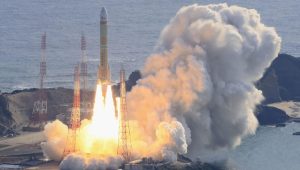Japan achieved a significant milestone in its space program with the successful launch of its new H3 flagship rocket on Saturday. This launch comes as a redemption after the setback of the rocket's failed inaugural flight last year. The Japan Aerospace Exploration Agency (JAXA) has seen a recent string of successes, including the “pinpoint” touchdown of its lunar lander, SLIM, making Japan the fifth country to land a spacecraft on the moon.
Despite being a relatively minor player in terms of the number of launches, Japan aims to revitalize its space program, particularly as it collaborates with the United States to counter China's advancements in space exploration. The H3 rocket took off at 9:22 a.m. local time (0022 GMT) from the Tanegashima Space Center in southern Japan. After successfully releasing a small satellite into orbit, jubilant scientists celebrated with applause, cheers, and hugs.
Masashi Okada, the JAXA project manager who led the decade-long development of the new rocket, described the H3's launch as its “first cry” and emphasized the need to prepare for the next H3 launch promptly. The H3 is set to replace the two-decade-old H-IIA rocket, which is retiring after two more launches. Another failure would have jeopardized Japan's independent access to space.
The first H3 launch in March ended in failure, with ground control destroying the rocket 14 minutes after liftoff due to a second-stage engine failure. JAXA cited three potential electrical faults but could not pinpoint the exact cause. Prime Minister Fumio Kishida praised the successful launch, highlighting its importance following the SLIM moon landing achievement.
The H3, standing at 63 meters (297 feet), is designed to carry a 6.5 metric ton payload. JAXA aims to reduce the per-launch cost to as low as five billion yen ($33 million) over time by adopting simpler structures and automotive-grade electronics. This cost reduction strategy is expected to attract global clients for satellite launch services.
Japan plans to launch about 20 satellites and probes using the H3 rockets by 2030 for domestic purposes. Additionally, the H3 is scheduled to deliver a lunar explorer for the joint Japan-India LUPEX project in 2025 and cargo spacecraft for the U.S.-led Artemis moon exploration program in the future.
The successful H3 launch adds Japan to the list of countries experiencing advancements in space exploration, with increased satellite launch demands driven by the availability of commercial vehicles like SpaceX's Falcon 9. Mitsubishi Heavy Industries, the primary contractor for the H3, aims to launch eight to ten rockets annually, requiring additional production capacity beyond its current capability of five to six H3 rockets per year.
